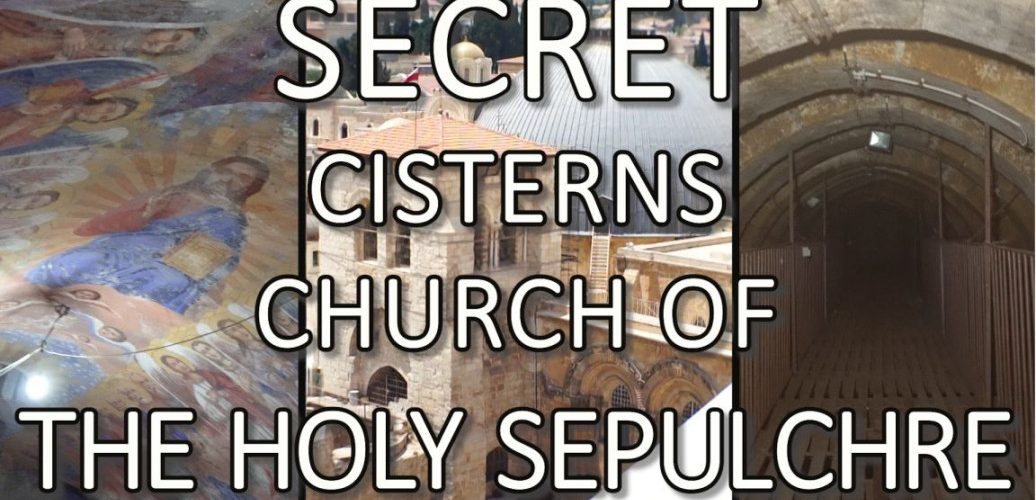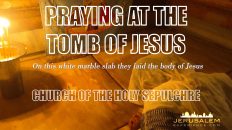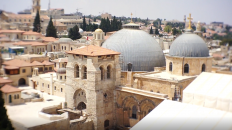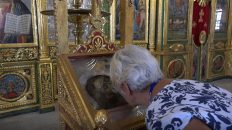The Cisterns of the Church of the Holy Sepulchre
Welcome to another Video Tour by JerusalemExperience.com, and today we are exploring the Cisterns around and below the Church of the Holy Sepulchre here in Old Jerusalem.
At the end of this video, we shall visit an impressive cellar and a vast cistern, not accessible to the public, beneath the Church of the Holy Sepulchre
The Church Floor Plant
The Church of the Holy Sepulchre, that we are visiting today, marks the sites of the crucifixion, the burial, and where the true cross of Jesus was found by Saint Helena Mother of Constantine – these 3 spots within the church mark the Cisterns we are visiting today.
The Quarry
During the time of Jesus, the site of the church of the holy speulchre was a huge stone quarry dated to the first and second temple eras. To learn more, watch our video tour of the Church of the Redeemer, which is next by.
Church of the Holy Sepulchre
We shall start our exploration, at the lower levels of the Church.
Our first stop is at the Armenian chapel of St. Helena, and the Chapel of St Vartan, both under the control of the Armenian patriarch in Jerusalem.
Next to the chapel altar, there is an iron gate that is closed most of the time. This gate leads to the quarry surrounding the church. It is like traveling back in time by 2000 years.
Through the quarry there is a path leading to the chapel of Saint Vartan, where the Armenian found the first graffiti ever made, by a Christian pilgrim, who came by boat, to pay respect to Jesus at the site of his crucifixion. This graffiti is about 1600 years old. Unbelievable!
We could touch a wall, from the temple that Hadrian built for Jupiter, in the 2nd century, after destroying Jerusalem.
Another wall is from the first basilica built by Constantine in the 4th century.
Right outside the Chapel of Saint Vartan, we could see that this quarry can host several cisterns some of which we shall visit today.
The Cistern where Helena found the true cross
Our next stop is at the lowest accessible point within the Church.
The place where Helena found the true cross. Every year on September 14th there is a special ceremony memorating the finding of the true cross by Saint Helena and for that, we have a special video.
Archeologists believe this site served as a cistern like the one in this snapshot from our next stop.
The Cistern at the Coptic chapel of Saint Helena
Our next stop is at the Coptic area, near the Church of the Holy Sepulchre and it is maybe 20 meters from the dry cisterns we have just visited within the church.
We are in the orthodox Coptic area at station number 9 to the Via Dolorosa.
The Cistern we are now visiting is within the Coptic Orthodox Chapel of St. Helena (the one we just saw earlier, is by the Armenian). Here in Jerusalem, each Christian denomination has its own place.
The Cistern we are now visiting is active, compared with the ones we have seen, within the Church of the Holy Sepulchre.
The Cistern BELOW the Church of the Holy Sepulchre
Our last Cistern is right beneath the Church of the Holy Sepulchre plaza.
Every day, hundreds if not thousands, walk above without knowing what is below. You should see me walking on a frail structure and rainwater beneath me.
You can hear the sound of water draining through this pipe and from the roof.
This Cistern is also part of the enormous stone quarry we have been seeing so far.
Secret cellars by the Greek Orthodox Patriarch
As I have promised at the opening, we will visit a secret underground cellar owned by the Greek Orthodox Church.
In this large cellar, Greek monks, who served at the Church of the Holy Sepulchre, gathered for dining sitting along with this very long marble table.
As you can see, today the Greek Orthodox Patriarch uses these cellars primarily for storage.
Look at the fantastic frescoes on the walls and imagine this room full of monks.
That is for today, and until we meet in our next video let’s live the Jerusalem Experience!





